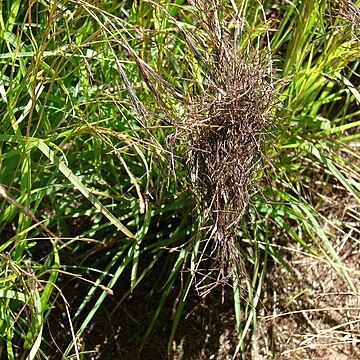Perennial or annual. Culms tufted. Leaf sheaths usually keeled; leaf blades linear; ligule membranous, sometimes with ciliate fringe. Inflorescence of solitary racemes, these terminal or axillary and loosely aggregated into a spathate panicle; peduncle included to long-exserted. Racemes linear, dense, spikelets imbricate, 1 to several pairs of homogamous spikelets at base of raceme below fertile pairs, fragile between fertile pairs; internodes and pedicels reduced to short oblique stumps obscured by hairs from backside of sessile spikelet callus. Homogamous spikelets herbaceous, flat, lanceolate-oblong. Sessile spikelet subterete; callus long, pungent, bearded; lower glume leathery, obtuse; upper glume awnless; lower floret reduced to a hyaline lemma; upper lemma stipitiform, entire, passing into a stout geniculate awn with hairy column. Pedicelled spikelet larger than sessile, resembling homogamous spikelets, awnless; callus slender, pedicel-like; true pedicel reduced to a stump.
Annuals or perennials. Leaf-blades linear; ligule very short, membranous, ciliate on the upper edge. Inflorescence a single raceme, these arising terminally and in the axils, sometimes loosely aggregated into a false panicle; racemes with homogamous spikelets for the lower 1/4–2/3 of their length; internodes linear. Sessile spikelet terete; callus pungent; lower glume coriaceous, convex, obtuse; lower floret reduced to a hyaline lemma; upper lemma stipitiform, passing directly into a hairy awn. Caryopsis lanceolate, channelled on one side. Pedicelled spikelet ♂ or barren, lanceolate, larger than the sessile, awnless, with a long slender callus functioning as a pedicel (true pedicel reduced to a little stump).
Inflorescence a single raceme, these terminal and axillary, sometimes loosely aggregated into a false panicle, partially enclosed by a narrow spatheole; racemes with homogamous spikelet pairs for the inferior 1/4–2/3 of their length; internodes linear, the pedicels reduced to a minute stump.
Sessile spikelet terete; callus pungent; inferior glume coriaceous, convex without a median groove, obtuse at the apex; inferior floret reduced to a hyaline lemma; superior lemma stipitiform, entire, passing directly into a stout pilose awn.
Pedicelled spikelet male or barren, lanceolate, larger than the sessile spikelet, awnless, with a long slender callus functioning as a pedicel.
Ligule very short, membranous, ciliate on the upper edge; leaf laminas linear.
Caryopsis lanceolate, channelled on one side.
Annuals or perennials.

